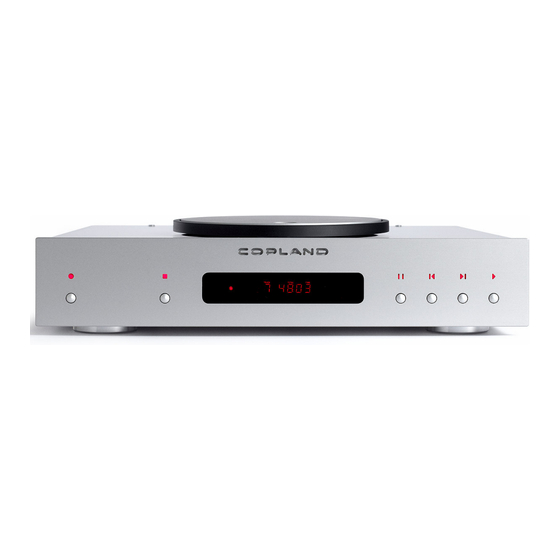
Subscribe to Our Youtube Channel
Summary of Contents for Copland CDA825
- Page 2 Ensure that no objects or fluids pass through openings in the chassis. If liquid is spilt into the CD-player, disconnect from the mains and consult a qualified service technician. As well as your CDA825 and this user manual, you should also have received the items below : Remote control...
- Page 3 ! " 1 ) Remove the stop knob 2) Insert the circular lid in this position. 3 ) Turn the lid to the closed position and mount the stop knob back in place.
- Page 4 On the backside of the CDA825, the connections below are to be found. The AC power cord is plugged here. & The correct mains operating voltage is printed just above the mains inlet Connect to CD-input of an amplifier. &...
- Page 5 The circular lid is manually opened and closed by rotating the lid to the left or right. . # * & By pressing this button, the CD-player will be switched between stand by " / & and operation mode cyclically. If servo finds a disc, it will show the TOC on the display.
- Page 6 The basis functions of the remote are the same as found on the front panel of the CD-player. However, the advanced functions below are to be found on the remote control only : Numeric buttons : Selection of track with numeric buttons. To designate a track directly, select the desired track number with the numeric keys, then press the “PLAY”...
- Page 7 Place the disc gently in the CD housing so that the centre of the disc sits right on the spindle and place the CD clamp on the top. Now close the lid. Wait a short time for the CDA825 to read the disc table of contents before you press PLAY.
- Page 8 Frequency response 20Hz-20kHz +/-0,1dB S/N ratio ( IHF-A curve ) Better than 100dB Phase linearity Less than 0,2” (20Hz-20kHz) Dynamic range Better than 100dB T.H.D. Less than 0.01 % D/A converter 24 bit. Dual differential Output Analog Single ended : 2,4V RMS. Balanced : 4,8V RMS.


Need help?
Do you have a question about the CDA825 and is the answer not in the manual?
Questions and answers